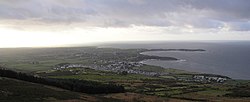Nefyn
| Nefyn | |
| Caernarfonshire | |
|---|---|
 A view over Nefyn | |
| Location | |
| Grid reference: | SH304405 |
| Location: | 52°56’6"N, 4°31’30"W |
| Data | |
| Population: | 2,619 (2001) |
| Post town: | Pwllheli |
| Postcode: | LL53 |
| Dialling code: | 01758 |
| Local Government | |
| Council: | Gwynedd |
| Parliamentary constituency: |
Caernarfon |
Nefyn is a small town and parish of Caernarfonshire on the north west coast of the Llŷn Peninsula, with a population of 2,619 at the 2001 census. Welsh is the first language of almost 80% of its inhabitants. The A497 road terminates in the town centre.
Contents
Name of the village
The name Nefyn is the Welsh cognate of the Gaelic Goddess Nebhain. Indicative of the settlement of Llŷn by Irish tribes in the 4th or 5th century. (The name "Llŷn" is believed to be the Irish Laighin; the men of Leinster.) The Romans recorded a tribe occupying the peninsula called the 'Gangani', who are also recorded as a tribe in Ireland. "Nevin" as an Irish female name means "worshipper of the saint".
However, Nefyn is another form of Nyfain, an early Welsh female saint.
History
The history of the area can be traced back to 300BC with the Iron Age hillfort of Garn Boduan overlooking Nefyn. The remains of 170 round stone huts and ramparts are still visible on top of the 917-foot hill.
The earliest known reference to Nefyn in documents dates from the latter part of the 11th century, where it is mentioned as a landing place of the Welsh prince, Gruffydd ap Cynan.[1]
Gerald of Wales writing in his account of a journey around Wales in 1188 states he slept at Nefyn on the eve of Palm Sunday.
The town was the place of a jousting tournament held by Edward I of England in 1284 to celebrate his victory over the last Prince of Gwynedd, emphasising its importance at that time as a trading town. In 1355 it became a free borough and remained an important centre of commerce.
The sea was always an important part of the economy of Nefyn and fishing, particularly for herring, became the prime trade for most of the 18th and 19th centuries: so much so that the town's coat of arms bears three herrings.
Parish church
The foundations of the old St Mary's parish church date from the 6th century, although the present building was erected in 1827. It would have been an important staging post for pilgrimages to Bardsey Island. The church is no longer a place of worship but houses a museum dedicated to the maritime history of Nefyn.
20th century and after
During Second World War, the Royal Air Force built a Chain Home radar station to the south-west of Nefyn.
A tremor in the area on 12 December 1940 was reported by the Cambrian News as having caused two fatalities including John Thomas of Nefyn who died of a heart attack.[2]
On 19 July 1984 an earthquake measuring 5.4 on the Richter scale had an epicentre near Nefyn. This is one of the strongest tremors recorded in the United Kingdom for recent times but caused little structural damage.
Outside links
| ("Wikimedia Commons" has material about Nefyn) |
- Former Nefyn resident's relatives in America
- Herring fishing at Nefyn
- Nefyn.com - This site contains stories and photos from a former Nefyn resident.
- The Last Great Nefyn Herring Catch 1950
- Draw Netting in Nefyn 1954
- An Evacuee's Story: From Kent to North Wales
- Shipbuilding in Nefyn
- Further archival information on Nefyn
- Flikr Search for Nefyn Photographs
- Panoramio Search for Nefyn Photographs
- - Online guide to the Llŷn Peninsula
- www.geograph.co.uk : photos of Nefyn and surrounding area
- British Geological Survey case study of landslide in Nefyn in 2001
References
- ↑ Roland Bond (2008). Nefyn: The story of an ancient Gwynedd town and parish. Gwasg Carreg Gwalch. ISBN 978-1-84524-124-7.
- ↑ Musson, RMW (2003) Fatalities in British earthquakes, in: Astronomy & Geophysics; 44 (1), 1.14–1.16. doi:10.1046/j.1468-4004.2003.44114.x "1468-4004.2003.44114.x". http://www.blackwell-synergy.com/doi/pdf/10.1046/j.1468-4004.2003.44114.x.